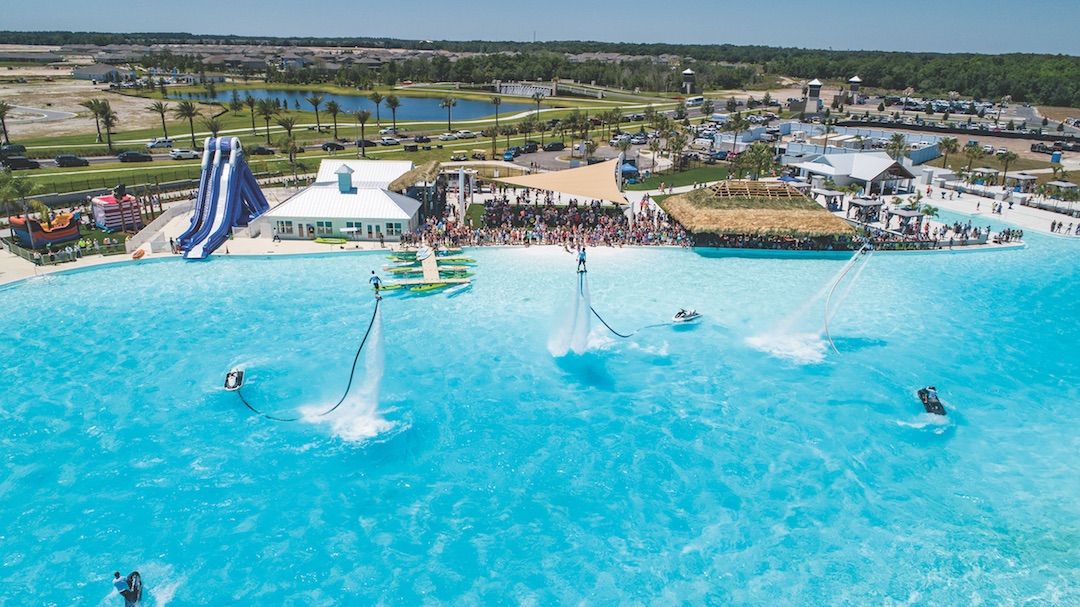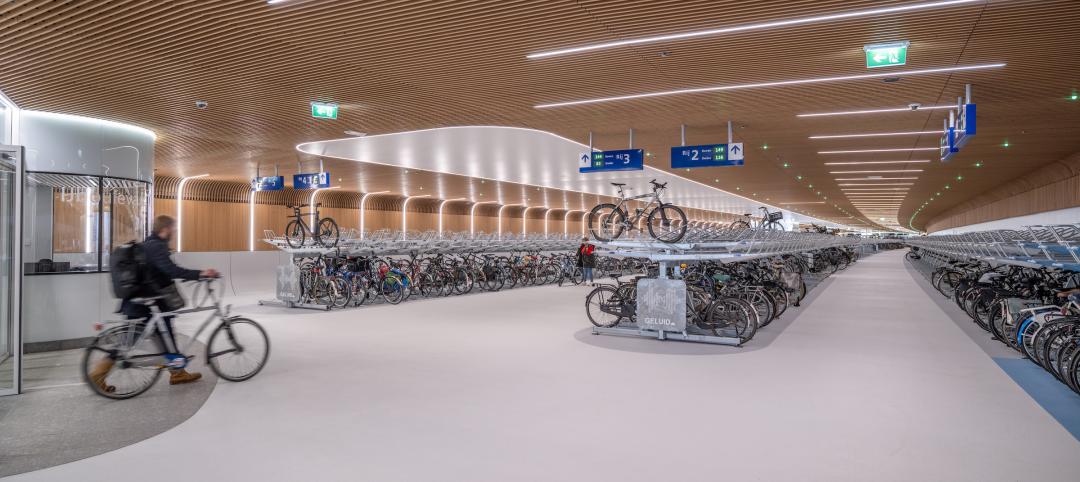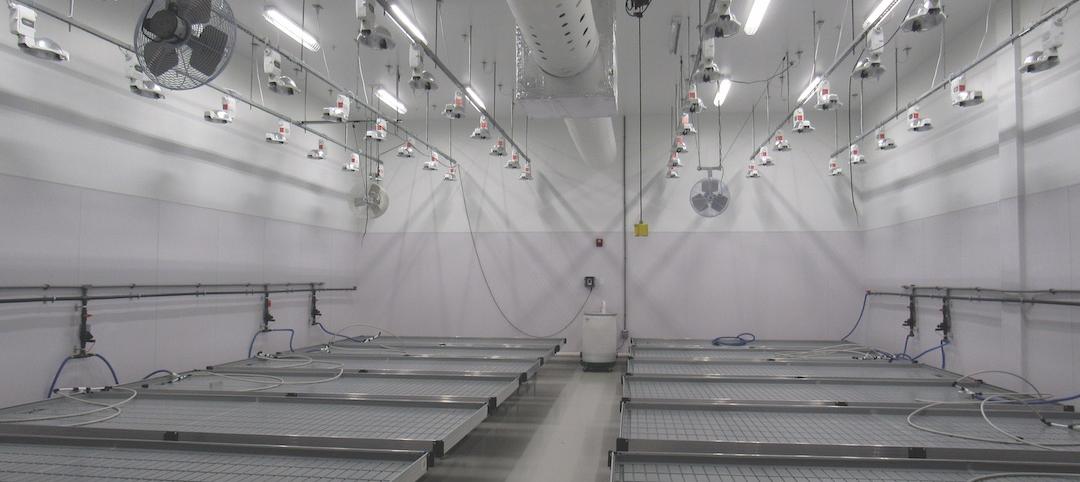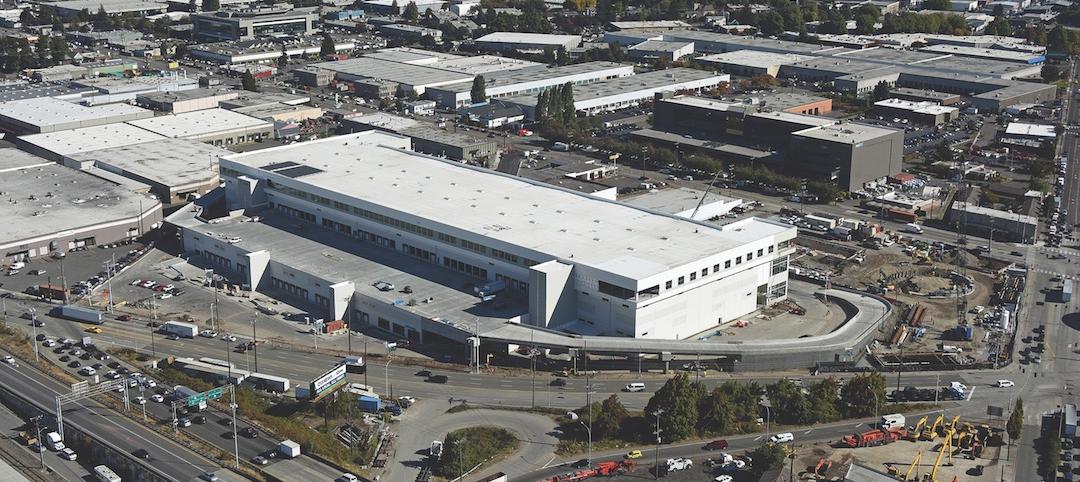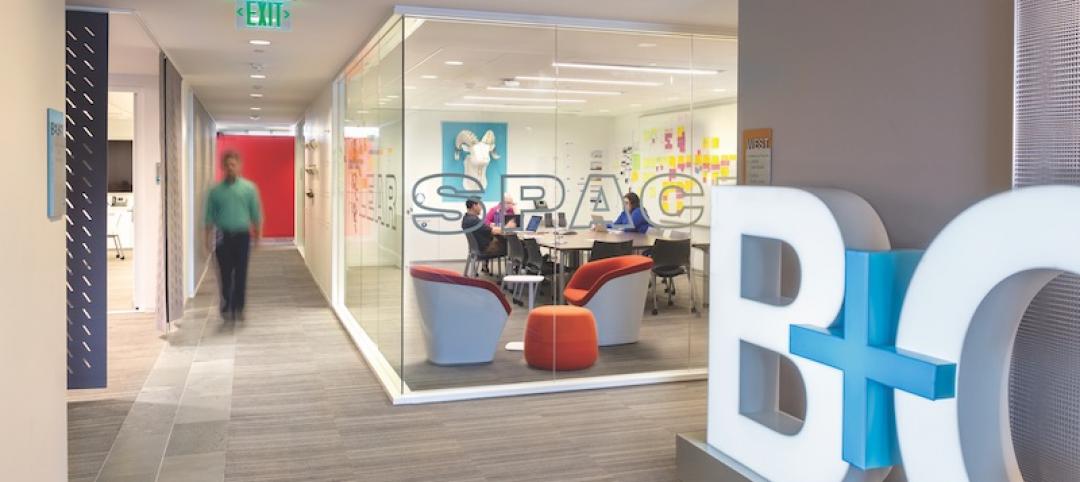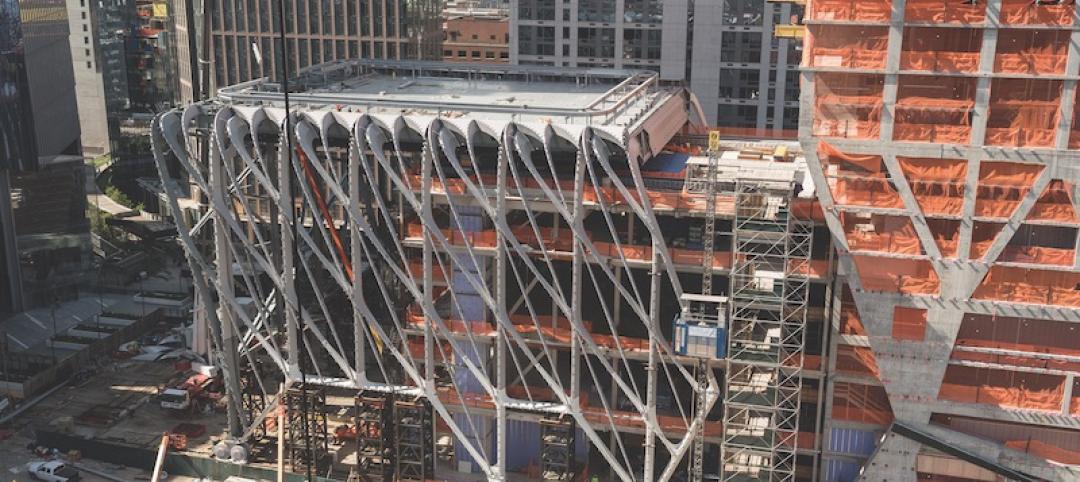One of the more extravagant amenities ever built is scheduled to open in New York City this spring. Called Vessel, this 150-foot-tall steel structure, with a price tag of at least $150 million, consists of 154 interconnected staircases with nearly 2,500 steps and 80 landings, which create a mile of climbable pathways.
Vessel is adjacent to The Shed, a $450 million education/arts/performance mega building with a massive retractable shell, set to open around the same time. They are part of the $25 billion Hudson Yards redevelopment that is positioned by its developer, The Related Companies, as “the new center of gravity” for New York, with a projected $19 billion annual contribution to the city’s economy.
Mega amenities like Vessel, which in the past might have been associated with the free-spending excesses of oil-rich Middle East emirates, are becoming less rare in major American cities. For example, MPK 21, Facebook’s new 524,000-sf, $300 million office building on its West Campus in Menlo Park, Calif., designed by Gehry Partners, includes a 3.6-acre rooftop garden and park with more than 200 trees and a 1.4-MW solar array.
In San Francisco, the recently opened (then closed for structural repair) Transbay Transit Center includes a 5.4-acre public rooftop park, designed by PWP Landscape Architecture, with a half-mile walking path, 200 species of plants and trees, real grass, and an amphitheater. Water jets for a 1,000-foot-long fountain that curves around the park’s north side are activated by sensors that track the movement of buses below.
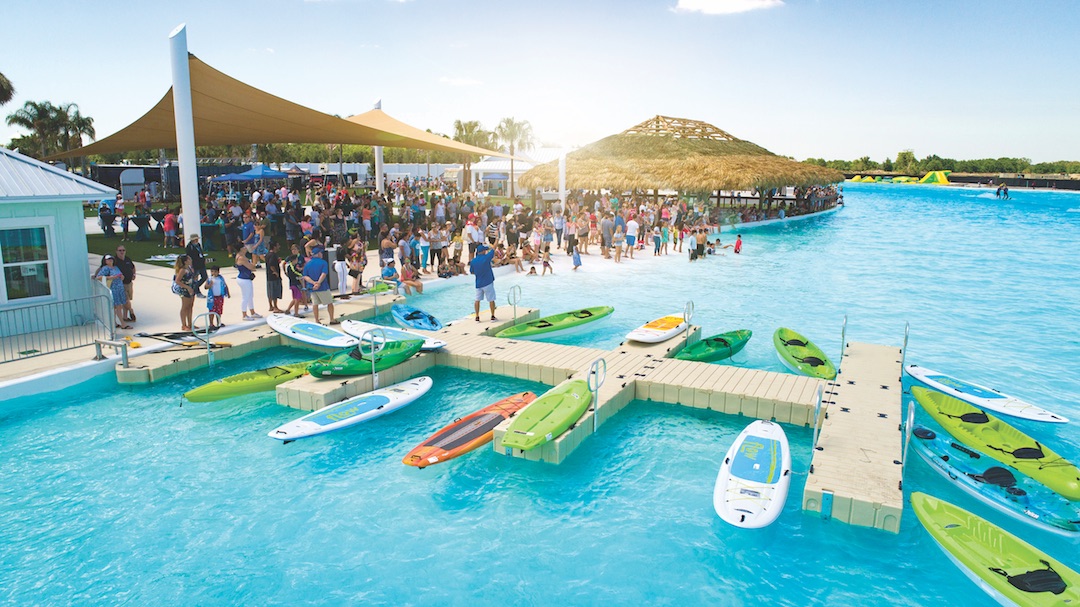 The Epperson master planned community, Tampa, Fla. Courtesy Cole Media.
The Epperson master planned community, Tampa, Fla. Courtesy Cole Media.
Are they worth the expense?
Large-scale amenities, especially indoor-outdoor spaces, are essential in commercial real estate projects, in part to appeal to Millennial occupants, says Ben Kochalski, Principal and Director of JBC West with The John Buck Company, a Chicago-based developer whose recent projects include the Park Tower high rise that includes 14 “skydecks” and two expansive terraces (see sidebar on page 32).
An amenities arms race is being waged in virtually every building sector. But what’s less discussed is the relationship between investment and return. Indeed, a study conducted by Newmark Knight Frank (bit.ly/2FV58A3) of 124 apartment buildings delivered within the last three years in the Washington, D.C., market found that the buildings with five or more social amenities, like fitness centers and pools, actually sold for around $32,000 less per unit than apartments in buildings with four or fewer amenities.
See Also: Indoor-outdoor amenities open leasing value at a San Francisco skyscraper
Kochalski is the first to admit that calculating the ROI of amenities is “incredibly difficult.” But he’s quick to note that his firm remains convinced that a building with “a heavy amenities load” leases quicker and creates higher demand.
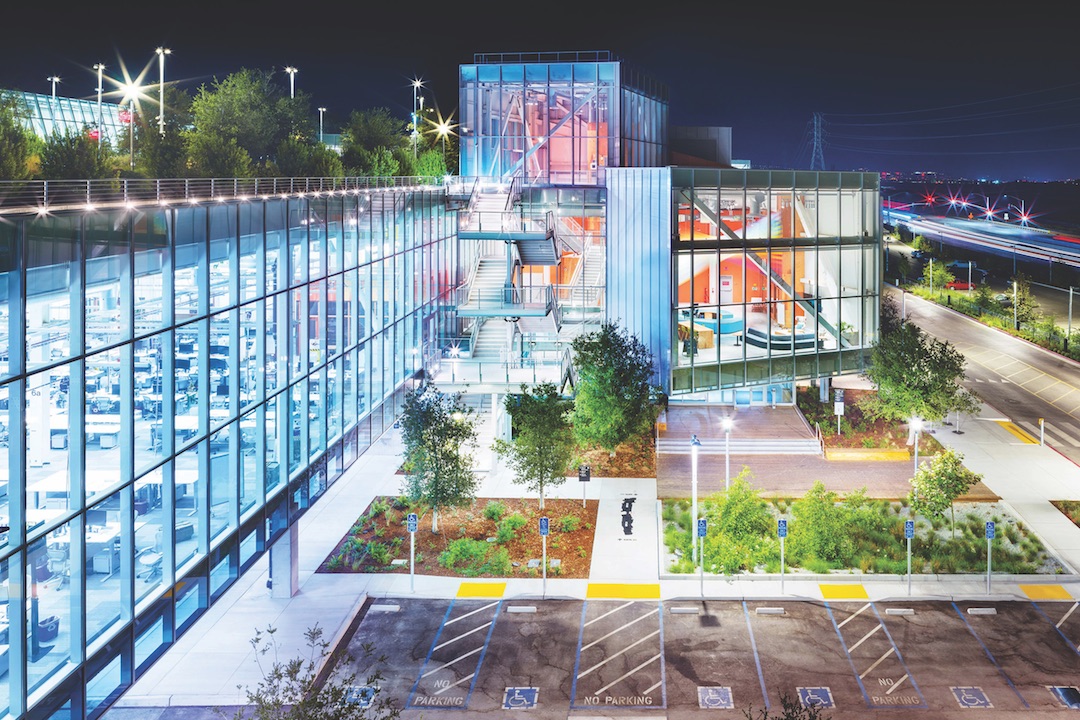 Facebook’s MPK 21 Menlo Park HQ expansion includes walking trails that weave around hundreds of trees, grasses, and shrubs. Courtesy Facebook.
Facebook’s MPK 21 Menlo Park HQ expansion includes walking trails that weave around hundreds of trees, grasses, and shrubs. Courtesy Facebook.
Add water, increase property value
The ROI of mega amenities is being tested to its fullest by Crystal Lagoons, a multinational company that licenses technology which allows developers to build and maintain crystalline lagoons of unlimited sizes and create a beach lifestyle just about anywhere.
Founded in Santiago, Chile, Crystal Lagoons entered the U.S. market in 2014. It has offices in Miami and Dallas, and is active in six states where it has negotiated 23 deals, with three lagoons in operation and two more set to begin construction, according to Kevin Moore, the company’s Executive Vice President.
Moore says lagoons are different from large public swimming pools by virtue of technology that uses 100 times fewer chemicals by “dosing,” or disinfecting, the water “only when necessary.” The lagoons also don’t require elaborate filtration systems—and therefore use 50 times less energy than a traditional swimming pool—by deploying ultrasound that sends particulates and sediment to the bottom, for easier removal and cleaning. Crystal Lagoons provides remote technical oversight of water quality via in-lagoon sensors. “We can make changes with a few keystrokes,” says Moore.
Lagoons cost anywhere from $650,000 to $1 million per acre to build, depending on the overall scale of the project, says Moore. Construction takes nine months to a year to complete. When asked why a developer would choose a lagoon over other, less expensive amenity options, Moore goes into his marketing pitch by ticking off “value levers” that include how lagoons elevate a B location to an A location and can help get developers to the end zone quicker.
After ESJ Capital spent $60 million to acquire Jungle Island, an 18-acre zoo in Miami, it came to Crystal Lagoons looking for ways to improve the zoo’s attendance. What Crystal Lagoons envisions, says Moore, is installing a two-acre lagoon with surrounding redevelopment that, if it works, might increase the zoo’s annual traffic to more than one million visitors, from its current level of 275,000, within a few years.
Crystal Lagoons’ first license in the U.S. was for a 7.5-acre lagoon within the 900-acre Epperson master-planned community in Wesley Chapel, Fla., whose plans include single- and multifamily homes and commercial buildings.
To assess this amenity’s ROI, Metrostudy conducted research over a seven-month period before the lagoon’s installation was completed last fall. The study found that Epperson’s four models were selling at a pace that was double the sales of the same models featured at three other master-planned communities. The Epperson models’ selling prices were more than 20% higher once the lagoon’s construction started.
Metro Development Group, Epperson’s developer, is convinced: it has signed licenses to include lagoons of between five and 15 acres at eight other communities in Central Florida. The firm also created its own “MetroLagoons by Crystal Lagoons” brand.
Roughly 80% of Crystal Lagoons’ current projects are part of mixed-use developments like Epperson and Beachwalk, a 1,000-acre master-planned community in St. Johns, Fla., with about 800 single-family and townhouse lots. Beachwalk includes a 14-acre lagoon with 37 million gallons of water, which will be accessible exclusively to residents. Planned commercial development includes retail, restaurants, a fitness center, 12,000-sf clubhouse, miniature golf, and a splash pool for pets. Future development could also include a high school on 70 acres, according to the Jacksonville Business Journal.
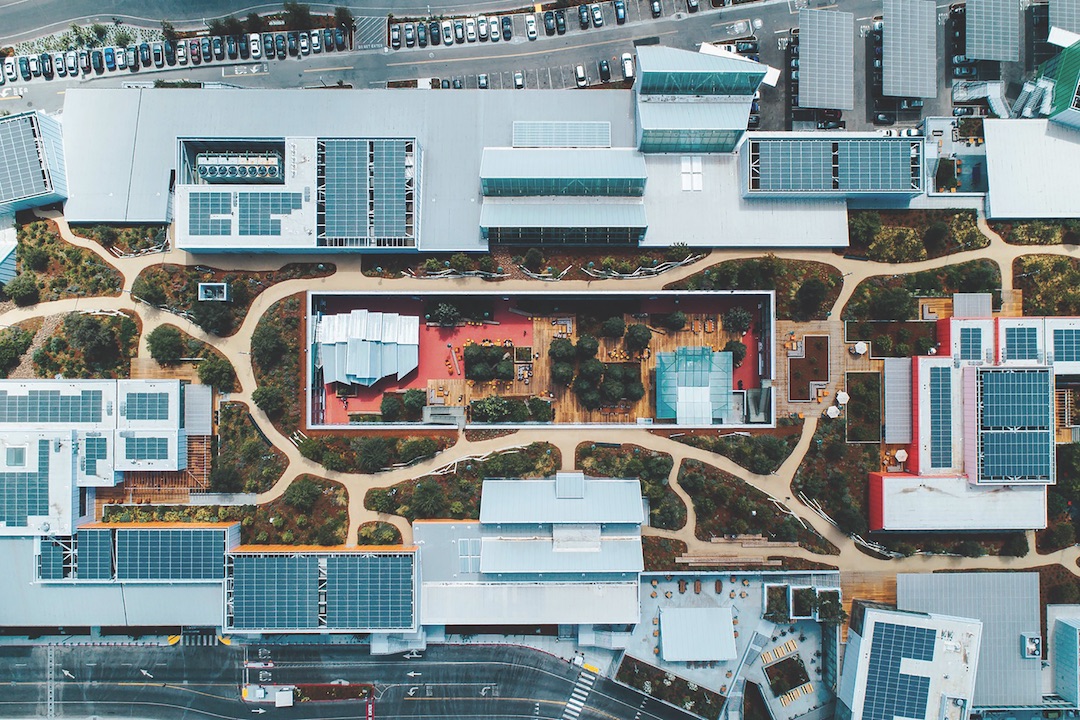 Facebook’s MPK 21 project, designed by Gehry Partners, added 3.6 acres of rooftop park space to the nine-acre park atop the MPK 20. Courtesy Facebook.
Facebook’s MPK 21 project, designed by Gehry Partners, added 3.6 acres of rooftop park space to the nine-acre park atop the MPK 20. Courtesy Facebook.
Suitable for hot or cold climates
Lagoons and other mega amenities are often viewed as “added amenities” that don’t necessarily make money but “stabilize the rest of the development,” says Alec Templeton, AIA, LEED AP, Senior Designer with AE7, a Pittsburgh-based design firm.
AE7 does a lot of work in the Middle East, including Dubai, where the developer Majid Al Futtaim last May signed a deal with Crystal Lagoons to include a 17-acre lagoon in its $3.8 billion Tilal Al Ghaf mixed-use community.
Jeff Wetzel, AE7’s Practice Director, says his firm has been working on another mixed-use project in Dubai, Mohammed Bin Rashid City District 1, which will include a 99-acre, seven-kilometer-long lagoon, straddled by beaches and walking trails.
AE7 introduced the lagoon concept to Lucas Piatt, President and CEO of Millcraft Investments, which is redeveloping a 15-acre industrial site in Pittsburgh for a mixed-used neighborhood called Esplanade, part of that city’s Chateau neighborhood redevelopment along the Ohio River. Esplanade is probably two years from starting construction, but its plans call for a two-acre public-access lagoon, in addition to a Ferris wheel, a marina, hotel, 300,000 sf of office space, and up to 600 residential units, according to Chris McCune, PE, Millcraft’s Project Manager.
This would be Crystal Lagoons’ first northern licensing agreement. Millcraft intends Esplanade to be a four-seasons community, with year-round thermal baths and a part of the lagoon that converts to an ice rink.
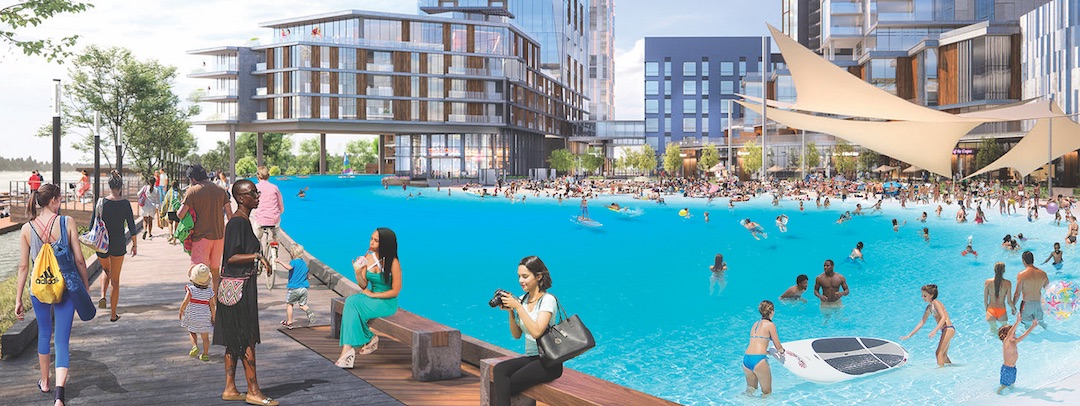 Esplanade, a 15-acre redevelopment project being planned in Pittsburgh and designed by the local firm AE7, will include a two-acre lagoon that’s accessible to the public year-round. During the winter months, part of the lagoon will serve as an ice-skating rink. AE7, Courtesy Crystal Lagoons.
Esplanade, a 15-acre redevelopment project being planned in Pittsburgh and designed by the local firm AE7, will include a two-acre lagoon that’s accessible to the public year-round. During the winter months, part of the lagoon will serve as an ice-skating rink. AE7, Courtesy Crystal Lagoons.
“We’re trying to activate the site,” says McCune, “and create a ‘first-day’ destination for visitors,” which Templeton explains means that all of the buildings and features at Esplanade would open simultaneously.
The AE7 and Millcraft executives note that another local ice rink—the $1 million, 13,456-sf Mass Mutual Pittsburgh Ice Rink at PPG Place—has become a popular attraction, which augurs well for the potential drawing power of Esplanade.
Crystal Lagoons’ next growth idea is even more ambitious: injecting new life into struggling shopping centers. Moore says his company has spoken with a number of REITs about replacing failing or bankrupt mall anchors with two- to four-acre lagoons, which would give the developers the opportunity to add food and beverage venues, hotels, even multifamily developments. Nothing’s been signed yet, but Moore is hopeful. “This would be part of the reinvention of retailing,” he says.
Related Stories
Cladding and Facade Systems | Apr 5, 2023
Façade innovation: University of Stuttgart tests a ‘saturated building skin’ for lessening heat islands
HydroSKIN is a façade made with textiles that stores rainwater and uses it later to cool hot building exteriors. The façade innovation consists of an external, multilayered 3D textile that acts as a water collector and evaporator.
Transportation & Parking Facilities | Mar 23, 2023
Amsterdam debuts underwater bicycle parking facility that can accommodate over 4,000 bikes
In February, Amsterdam saw the opening of a new underwater bicycle parking facility. Located in the heart of the city—next to Amsterdam Central Station and under the river IJ (Amsterdam’s waterfront)—the facility, dubbed IJboulevard, has parking spots for over 4,000 bicycles, freeing up space on the street.
AEC Innovators | Mar 3, 2023
Meet BD+C's 2023 AEC Innovators
More than ever, AEC firms and their suppliers are wedding innovation with corporate responsibility. How they are addressing climate change usually gets the headlines. But as the following articles in our AEC Innovators package chronicle, companies are attempting to make an impact as well on the integrity of their supply chains, the reduction of construction waste, and answering calls for more affordable housing and homeless shelters. As often as not, these companies are partnering with municipalities and nonprofit interest groups to help guide their production.
AEC Tech Innovation | Jan 24, 2023
ConTech investment weathered last year’s shaky economy
Investment in construction technology (ConTech) hit $5.38 billion last year (less than a 1% falloff compared to 2021) from 228 deals, according to CEMEX Ventures’ estimates. The firm announced its top 50 construction technology startups of 2023.
Game Changers | Oct 4, 2019
Call to action: BD+C is looking for the industry’s next game-changing projects
Is your firm working on a project that could be the next advance in design, engineering, technology, or construction? If so, send us information about it for possible inclusion in our upcoming “Game Changers” feature.
Game Changers | Jan 17, 2019
The coming bonanza in marijuana facilities
AEC firms are rushing to fill orders for cannabis facilities in the 33 states where the sale of marijuana is now legal.
Game Changers | Jan 16, 2019
In the age of Amazon there's nowhere to go but up
Multistory warehouses could help speed ecommerce delivery in urban centers.
Game Changers | Jan 15, 2019
IPD super teams hit jackpot for clients
Meet the firms achieving double-digit returns using true, shared-risk, multi-party integrated project delivery.
Game Changers | Jan 17, 2018
Is farming ready to grow up?
Armed with the latest agri-tech and millions in VC funding, vertical farming startups believe they’ve cracked the code on indoor farming.
Game Changers | Jan 16, 2018
Shape shifters: Kinetic architecture allows buildings to perform beyond their intended purpose
Kinetic architecture can bring practical and aesthetic value to an already ambitious project.


